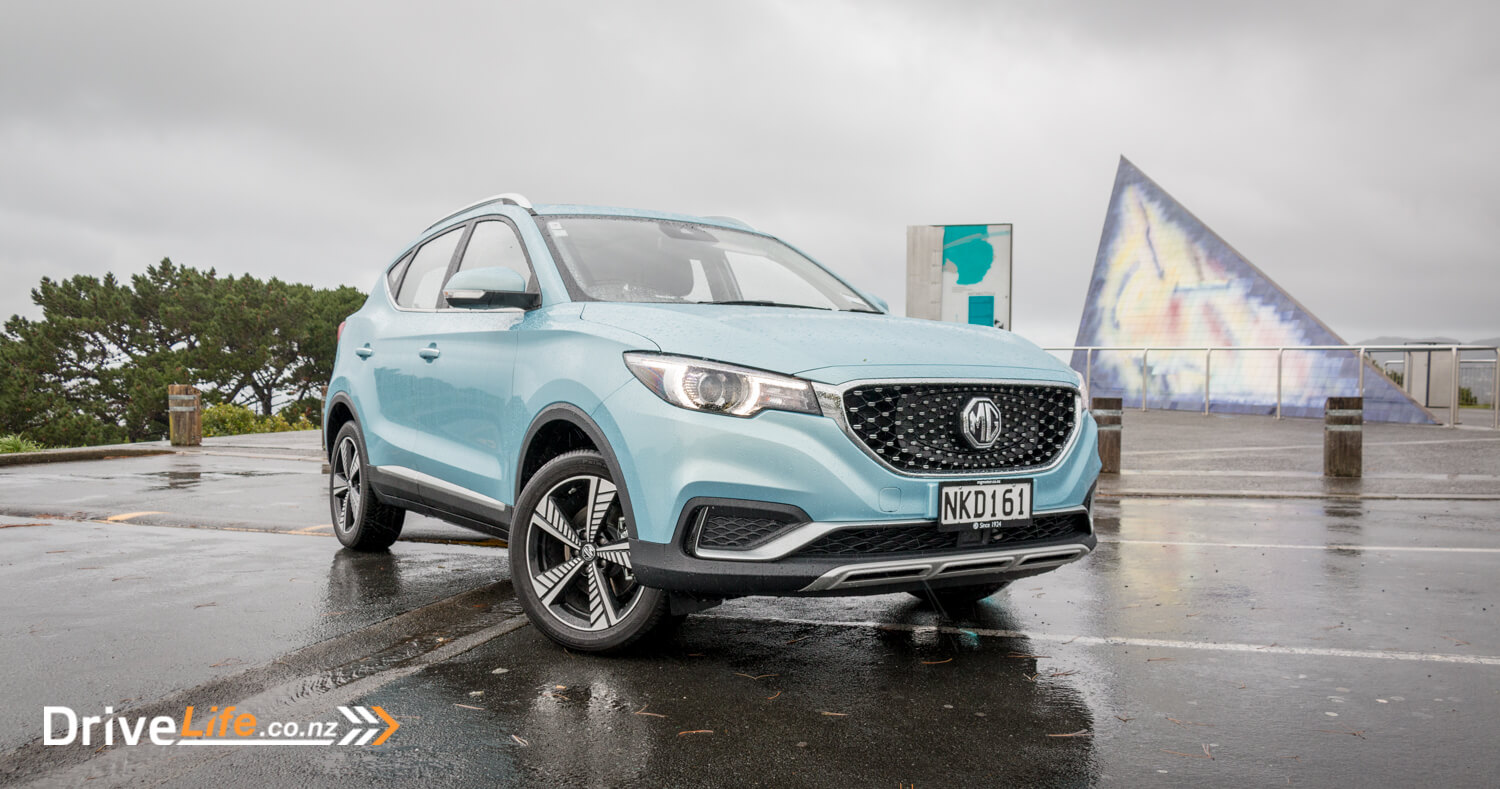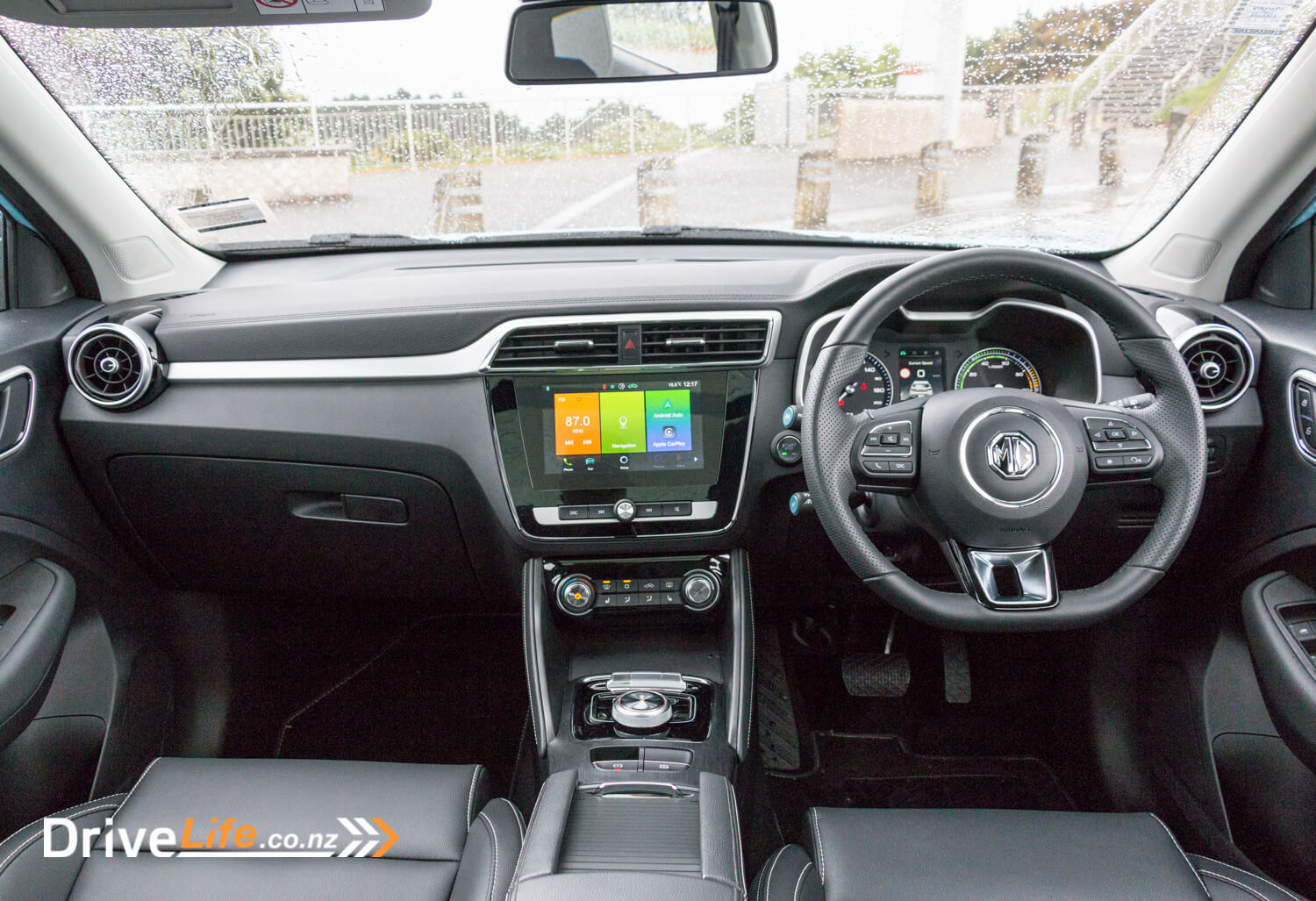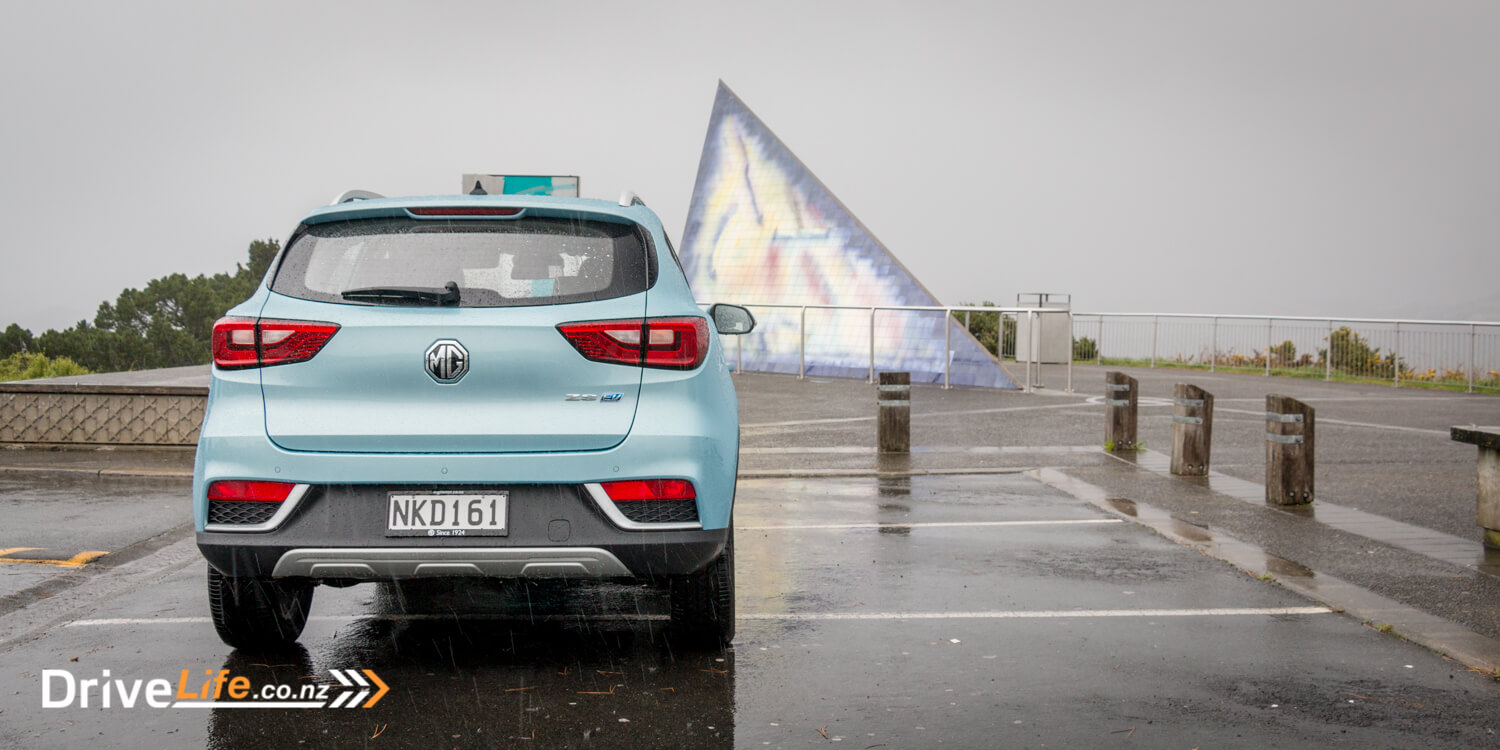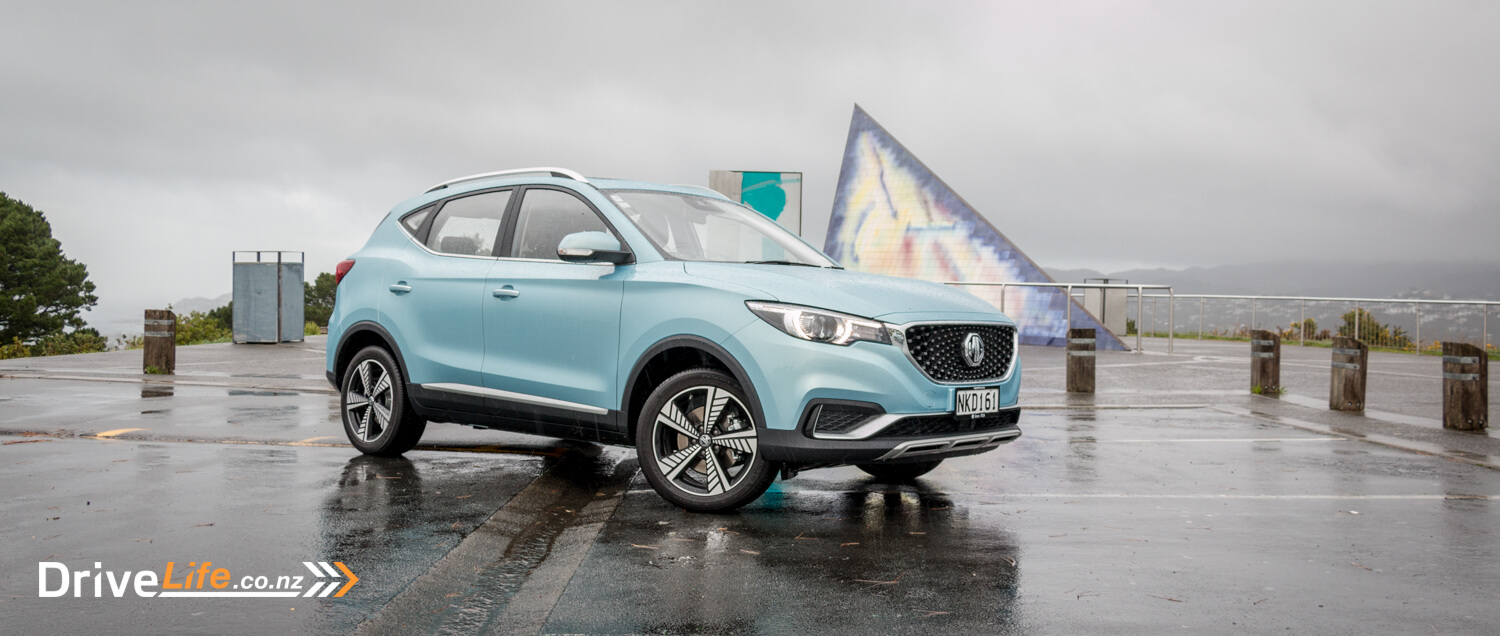The electric version of the MG ZS small SUV is New Zealand’s cheapest electric car. And with the freshly announced government subsidy it gets even cheaper, not much over $40k. And at that level it’s much more affordable for New Zealand families.
How does it compare to its more expensive rivals? We spent a week in one to find out, in one of Wellington’s wettest weeks of the year.

What’s In The 2021 MG ZS EV Range?
If you want the EV, there’s just one trim level of ZS, called Essence, priced at $48,990 plus on-road costs. After the rebate that’s $40,365. Included is an 8” touch screen, Apple CarPlay and Android Auto, 6-way electric driver’s seat, heated front seats, leather trimmed steering wheel, panoramic glass sunroof, keyless entry and start, satellite navigation, synthetic leather interior trim, MG Pilot Driver Safety Technology, rear view camera, 17″ alloy wheels, and a liquid-cooled 44.5kWh lithium-ion battery.
MG Pilot includes traffic sign recognition, smart cruise control with traffic jam assist, rear cross traffic alert, active emergency braking, lane keep assist, auto high beams, and blind spot detection. Other safety features include brake assist, ESP, active cornering brake control, hill start assist, and pedestrian alert.
Power is 105kW, with 353Nm of torque, driving the front wheels. WLTP range is 263km. The ZS can be charged from 0% to 80% in 45 minutes using a 50kW DC charger, for a 7kW AC installed home charger it takes approximately 7 hours. For a 22kW public charger it takes approximately 2.5 hours. For the 10A home charger with domestic plug supplied it takes around 30 hours.
Colours available are black, white, red, light blue (as seen on our review car) and dark metallic blue. The three colours cost $500 extra.
You can read more about the MG ZS on MG’s website.

First Impressions Of The 2021 MG ZS EV
The petrol ZS is becoming a familiar sight on New Zealand’s roads, and the electric version looks pretty much the same. This is a good thing in my opinion, EVs should just look like a normal car, they don’t need to be differentiated by a load of bright blue badges, or weird looking blanks where the grille would be.
My first impressions of the EV version were very good, it’s a smart looking car. Our review car came in Clipper Blue, with brushed chrome highlights, and black plastic along the bottom to give it a chunkier SUV look. The EV-exclusive 17” wheels look smart without being too over-designed. Overall it’s a good-looking car – not trying too hard, but not too bland-looking either.

What’s The Interior Like On The 2021 MG ZS EV?
The steering wheel is leather-wrapped with a slightly flattened bottom, which looks good with contrasting stitching, and has comfortably-shaped grips where you need them. There are buttons on the right to control the trip computer and displays, and stereo and phone controls on the left. All are logically laid-out and easy to use without looking down.
MG have designed an uncomplicated, functional, good-looking interior. Mostly finished in dark grey plastic, but with enough brushed metal and chrome trim to lift the feel from basic to a little more premium. There’s contrasting stitching on the seats and centre console trim, and some piano black around the main screen and gear shifter. The plastics are clearly made to a budget – don’t forget the petrol ZS starts at $23k – but they feel solid enough.
Cruise control is activated using a third stalk on the left of the wheel. This is perfectly functional when you get used to it but the stalk is the same length and size as the indicators so I occasionally tried to indicate and changed cruise settings instead.

The instruments are pretty traditional with two main analogue dials and a central digital display, the left dial being a speedo and the right a power/charge meter. Battery voltage and main battery charge meters are at the bottom. I’m not sure what the value is of knowing the accessory battery voltage at all times, maybe they couldn’t think of anything to put there.
The 8” central touch screen is clear and bright, and easy to reach and there are physical buttons for volume and track skipping, which we always like to have. Aircon in the ZS EV is manually controlled with a knob for hotter or colder, and a knob for fan speed. It’s an electrically powered traditional HVAC system rather than a heat pump, it works well and clears the windows in damp weather as long as the AC is on (I had lots of opportunities to test this!).

The gear shifter is a rotary knob for shifting reverse, neutral or drive. Pressing it down puts the car into park. Very simple, but it can be fiddly when doing multi-point turns and switching between drive and reverse.
Above the shifter are toggle switches for drive modes (Eco, Normal, Sport). KERS (3 levels of battery regen level), and battery charge – flick this to see the charge percentage at any time.
Finally we have the electronic parking brake and Auto-Hold buttons. Fred will be happy to hear that Auto-Hold stays set after stopping and re-starting the car.
There are two central cupholders with a sliding cover, and a smallish storage bin for your bits and bobs.
The seats feel comfortable, with good side support in the front and 6-way electric adjustability for the driver. The passenger has to make do with manual adjustment. Rear space is good, with enough knee room for adults, and a totally flat floor thanks to the EV design.
The boot is a quite generous 359 litres, or 1187 with the 60/40 split back seats folded down. The boot floor can be inserted at two different levels to form a flatter load space or a deeper boot as required. Under the floor are compartments for your 10-amp charger and tyre inflation kit.

What Does The 2021 MG ZS EV Drive Like?
When your daily is an ICE (internal combustion engine) car you forget just how quiet EVs are, and I had to be extra careful crossing the footpath out of the MG dealership when I collected the ZS. Pedestrians just aren’t aware, despite the bright blue colour of our review car they just didn’t seem to see it.
Around town the MG feels quick and nippy, small enough for easy lane changes and easy to manoeuvre and park. The parking sensors front and rear show the distance in cm from an object rather than just a series of blobs, and I really liked that. In traffic you’re sitting high and have good visibility. The seats are comfortable enough that I never thought about them at all, always a good sign.
There are three driving modes – Eco, Normal and Sport. As you’d expect, Eco softens the throttle response, making for slower acceleration, Normal is a bit perkier, and Sport gives you a much sharper response. The ZS EV gets from 0-100 in 8.0 seconds, which is pretty respectable, and plenty for a small city car. On wet roads it’s easy to chirp the front tyres setting off, and there’s noticeable torque steer if you mash the throttle – not that this is the sort of car you’ll be driving that way. Drive mode goes back to Normal every time you start the car, and I just left it there most of the time.

There are also three regenerative braking modes, going from none, to quite aggressive. On the most aggressive setting you can almost drive using just the accelerator, only occasionally using the brakes. I left it in this mode all the time as having “engine braking” suits my driving style. This setting does stick when you turn the car off and back on, as does the handbrake auto-hold setting.
There’s smart cruise control which can come to a complete stop and set off again with a dab of the accelerator, or the cruise stalk. This worked well and gave no surprises.
The ride is firm, but comfortable enough, and at motorway speeds it’s quiet without too much tyre noise. When there’s no engine vibrations, other noises are much more apparent but MG seem to have done well here. It’s always a little surprising to hear other people’s car stereos as they pass you in your almost-silent EV.
Talking of stereos, the MG’s system is good, with clear sound and reasonable bass, and it has Apple Carplay and Android Auto built-in. The display is bright and clear but is noticeably slow and laggy. It seems to take time to boot, and particularly using Satnav it seemed to be from an older generation of car. The traffic sign recognition system did work well, making the occasional mistake as all of these systems do, but it was mostly accurate. If you do go over the speed limit there’s a subtle flash behind the detected speed to warn you.
During my rather soggy Wellington week, I was always aware that the HVAC system in an EV is the biggest drain of its battery apart, of course, from making the wheels turn. At first I was reluctant to use the aircon, a little bit of range anxiety starting to happen, but after a while I got sick of the windscreen steaming up so I just turned it on and left it on. And in the end I averaged 17.3kWh/100km, which is better than MG’s quoted figure of 18.6.

One morning the windscreen was covered in moisture on the outside, and the dash kept warning me that the front camera was obscured. Activating the wipers doesn’t seem to clear the camera and it took a few minutes of driving to clear properly. This was the only “issue” I had with the car, apart from one little safety feature that mildly irritated me. I was reversing close to another car in a tight driveway and couldn’t quite judge where the back was so I opened the driver’s door for a look. The MG put its handbrake on, switched to Park and told me to close the door. I should use the mirrors properly I guess.
Tell people you’re driving an EV and the first thing everyone asks is “What’s the range?”. The ZS EV has a stated WLTP combined range of 263km on a full charge. Tell them anything less than 400km and they are generally unimpressed. But practically, it doesn’t matter because most of these same people do no more than 40km a day, usually less. Just plug the car in at home every other night, you’ll never get near even 50% range. Once you use an EV for a while the range becomes less and less of a concern to you as you realise that having the battery.

What’s The Competition For The 2021 MG ZS EV?
| Brand/Model | Power/Torque kW/Nm | Seats | Cargo capacity, litres | 0-100km/h, seconds | Range WLTP | Economy, kWh/100km, WLTP | Price (pre-rebate) |
| Hyundai Kona Electric | 1150/395 | 5 | 332 | 7.1 | 400 | 14.3 | $78,990 |
| BMW i3 | 125/250 | 4 | 260 | 7.3 | 260 | 14.2 | $78,700 |
| Hyundai Ioniq EV Entry | 100/295 | 5 | 350 | 8.1 | 311 | 11.5 | $65,990 |
| Kia Niro EV EX | 150/395 | 5 | 451 | 7.8 | 455 | 14.3 | $77,990 |
| Tesla Model 3 Standard Range | 211/406 | 5 | 542 | 5.6 | 460 | 16.0 | $74,900 |
| VW e-Golf | 100/290 | 5 | 341 | 9.6 | 220 | 12.7 | $69,490 |
| Nissan Leaf | 5 | 7.9 | $61,990 | ||||
| MINI Cooper SE Electric | 135/270 | 4 | 211 | 7.3 | 233 | 15.2 | $59,990 |
| MG ZS EV | 105/353 | 5 | 359 | 8.2 | 262 | 18.6 | $48,990 |

What’s The Pros and Cons For The 2021 MG ZS EV?
| Pros Performance Quiet Good stereo Comfortable Spacious Price | Cons Screen laggy and slow Some control ergonomics could be improved |

2021 MG ZS EV – Specifications
| Vehicle Type | Electric, 5-door small SUV |
| Starting Price | $48,990(After rebate $40,365) |
| Price as Tested | $49,490(After rebate $40,865) |
| Engine | Synchronous motor |
| Power, Torque kW/Nm | 105/353 |
| Transmission | N/A |
| Spare Wheel | Tyre repair kit |
| Kerb Weight, Kg | 1,532 |
| Length x Width x Height, mm | 4314 x 1809 x 1644 |
| Cargo Capacity, litres Seats up/seats down | 3591187 |
| Battery capacity, kW | 44.5 |
| Efficiency, kW/100Km | Advertised Spec – combined – 18.6 Real World Test – combined – 17.3 |
| Towing Capacity Kg, unbraked/braked | N/A |
| Turning circle, metres | 11.2 Small: 6-10m / Medium 10-12m / Large 12m+ |
| Warranty | 7 Years / Unlimited Mileage Vehicle Warranty 7 Years Anti-Perforation Warranty 7 Years / Unlimited Mileage Battery Warranty (for non-commercial use) |
| ANCAP Safety Ratings | 5 stars |














